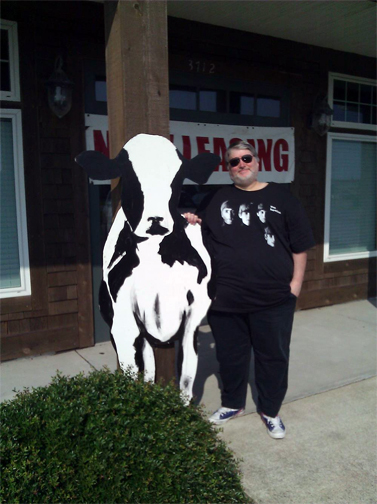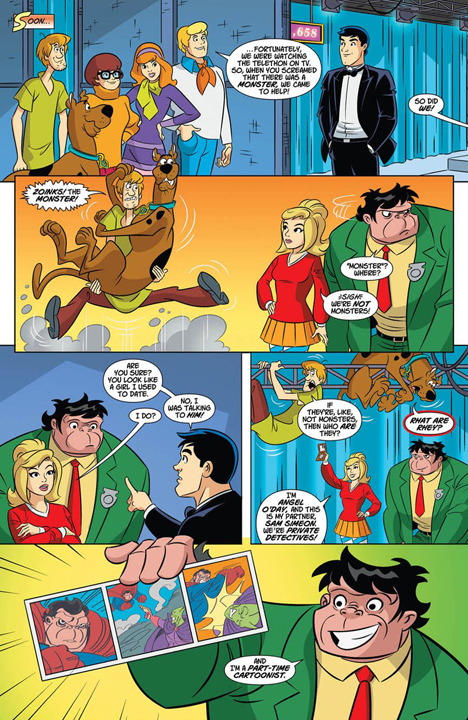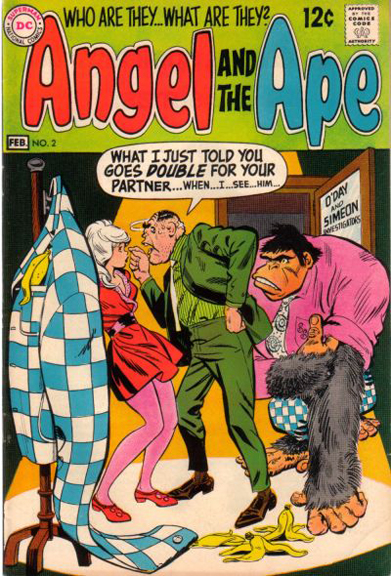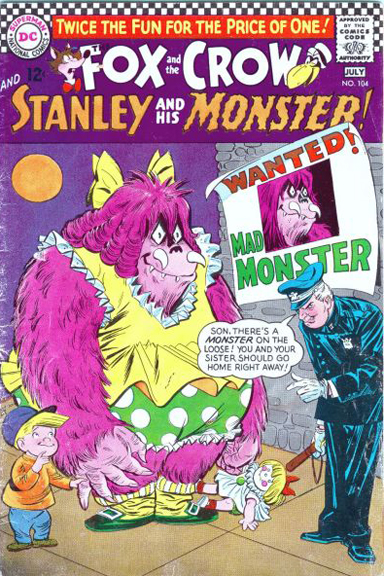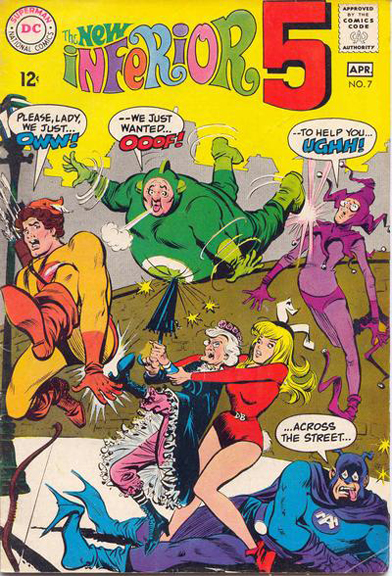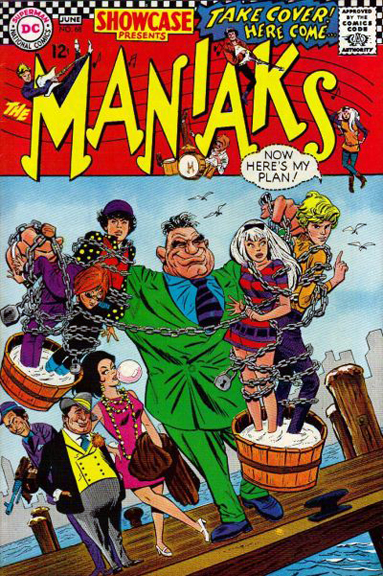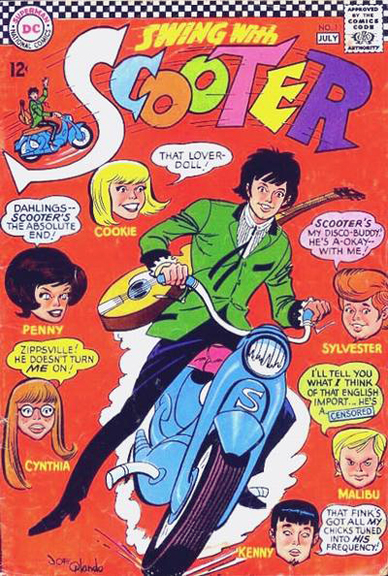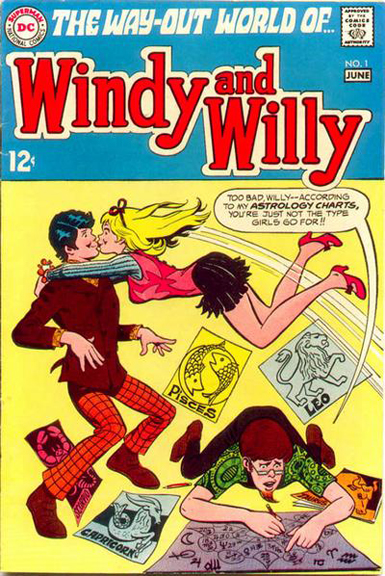SCOOBY-DOO SUPER SMASH-UP!
A KC COLUMN By KC Carlson
Sometimes I think I’m too old to be enjoying Scooby-Doo Team-Up as much as I do. Although, given that most of the characters that appear in the most current issue were created during the 1960s (or even earlier), I also wonder who this issue is being written for. Since most of the characters that appear here haven’t appeared in a DC comic book for a looong time, maybe I am the target audience!
No guest-stars are specifically credited on the cover of this issue, a departure from usual practice for the series. But old fogies like me instantly know who the co-stars are: Angel and the Ape! Although they are only referred to as Angel O’Day and Sam Simeon (their “real” names) in the comic itself. Has DC abandoned (or forgot to renew) the Angel and the Ape trademark/title for some reason? Interesting…
The real fun is not trying to figure out this particular mystery. (That’s for old geeks like me and Wayne to scratch our beards about.) The real fun in Scooby-Doo Team-Up #36 is figuring out who all the other old DC characters are — because this issue is packed to the gills with obscure DC folks, including a few “unofficial” ones that definitely are no longer DC trademarks.
As usual, I’m getting ahead of myself. This issue (written by the very silly Sholly Fisch and cartooned — and I’m not saying this as an insult — by the frequently brilliant artist Dario Brizuela) is solidly stuffed with obscure characters, dialogue, jokes, and probably even stuff I missed. It’s set up as the annual Louie Jervis Telethon for the United Charities which (of course) is hosted by comedian/movie star Louie Jervis — who announces that comedian/movie star Rob Pope is also performing. If these names don’t sound familiar, then you haven’t watched enough telethons hosted by either Jerry Lewis or Bob Hope — who both coincidentally starred in their own DC Comic Books published from the 1950s to the early 1970s. (Most likely, DC no longer has rights for either of them. Which is why you probably will never see a collection of either of those titles — despite all the great work in them.)
HALOS AND BANANAS
Before we get too far along, Angel and the Ape was created and frequently written by E. Nelson Bridwell. He is best known as the long-running Superman assistant editor (most notably under editor Mort Weisinger) because of his encyclopedic knowledge of the character’s history.
The artists most associated with the original series were penciller Bob Oksner and inker Wally Wood. Oksner was also the long time artist of The Adventures of Jerry Lewis and The Adventures of Bob Hope. Concentrating mostly on humor series for DC, Oksner also illustrated The Many Loves of Dobie Gillis (see more below), Sgt. Bilko, Pat Boone, and Welcome Back, Kotter. He was also the artist on the syndicated I Love Lucy newspaper strip in the 1950s. As DC’s humor titles eventually died out, Oksner switched to features like Superman, Supergirl, Shazam!, and Superman’s Girl Friend, Lois Lane.
It would take a column longer than this one to acknowledge Wally Wood’s contributions to comic books.
Angel O’Day is a private investigator and a partner in the O’Day and Simeon Detective Agency — with her partner Sam Simeon. Sam is quite an unusual character: Not only is he a talking (kinda) gorilla, he’s also a comic book artist, working for a possibly insane editor who may or may not have been based on Stan Lee.
Angel is impossibly beautiful. (She occasionally models for Sam for his comic book work.) She is also fantastically brilliant at her detective job. This first series lasted for eight issues after a tryout. (Showcase #77, Angel and the Ape #1-7, and the last issue renamed as Meet Angel #8.)
In the 1990s, the series was revived by Phil Foglio, who stuck to its earlier zany roots. In the 1991 Angel and the Ape miniseries, it was revealed that Angel is the half-sister of Dumb Bunny (a member of the Inferior Five (see below) — and both characters were created by E. Nelson Bridwell). Sam was also re-tooled. He became the grandson of Gorilla Grodd (the Flash villain). He was also given mental powers to make people see him as a human being. I think most people thought that this was an unnecessary change (at least I did), and I’m not sure if it’s still part of the character.
I’m also obligated to tell you that there is a four-issue Vertigo version of the Angel and the Ape series, written by Howard Chaykin and David Tischman and Illustrated by Phillip Bond with covers by Arthur Adams. As much as I admire all these men’s work, I’ve never been able to actually read this series. I am afraid.
Other modern Angel and the Ape appearances include the DC Holiday Special ’09 (one page by Andrew Pepoy) and an ongoing segment in the 2012 Joe Kubert Presents anthology title. I hope there will be more appearances of the duo in the future — with their title intact.
WAS THIS ANOTHER KIND OF PARODY OF STAN LEE?
Also appearing in this Scooby-Doo Team-Up issue is a little boy who has a strange-looking pet. Stanley and His Monster was about a boy and his pet monster. Stanley (who wasn’t too bright) actually thought this seven-foot-tall, pink-furred, mild-mannered beast was a dog. (Nope, he really was a monster.) It was created by writer Arnold Drake and artist Winslow Mortimer and appeared as a feature in The Fox and the Crow beginning in issue #95 (January 1966) and running through issue #108. With issue #109, the title changed from The Fox and the Crow to Stanley and His Monster which ended exactly three issues later in #112.
Supporting characters in the series included a leprechaun (named Shaughnessy Poltroon), a gremlin (Schnitzel), and the ghost of French emperor Napoleon. (I’m really not making this up!) There was also Stanley’s sexy teenaged babysitter Marsha — who also looked a lot like Angel from Angel and the Ape. (Another unrevealed younger sister?) BTW, Jerry Lewis guest-stars in Stanley and His Monster #110.
With a cast like this, of course, more comic book weirdoes came along years later and revived them. Most notably Phil Foglio in a four-issue miniseries in 1993 (after contributing the characters’ origins in Secret Origins #48 in 1990). Foglio parodied Vertigo-style storytelling elements in his stories. Kevin Smith revived the characters again in 2001 in Green Arrow (of all places), showing Stanley as a young teenager. (With incidents more graphic and unfunny. Not recommended.) More adult appearances of Stanley occur in Infinite Crisis #6 and a storyline in Batman/Superman: Sorcerer Kings in 2011.
THEY’RE NOT INFERIOR! THEY’RE JUST MISUNDERSTOOD…
As I mentioned above, where Angel goes, her sister may wind up as well. The Inferior Five was created in 1966 by writer E. Nelson Bridwell and artist Joe Orlando. This superhero parody team consisted of Awkwardman, Merryman, White Feather, The Blimp, and Bunny (formerly Dumb Bunny). They were the sons and daughter of a number of members of the Freedom Brigade (a parody of both the Justice League and the Justice Society). The older heroes retired, hoping that their children would carry on the family super-tradition. Sadly, none of them really wanted to, nor had the talents (or powers) to be truly effective — thus, their self-chosen team name. They first appeared in Showcase #62, 63, and #65 before graduating into their own 12-issue series (only the first 10 were new material).
Like a lot of these other characters, they eventually appeared in Showcase #100, and then sporadically around the DC Universe. Their best appearance was in Batman: The Brave and the Bold #17. Later, the I5 team up with the Legion of Substitute Heroes in The Brave and The Bold #35 and with Bat-Mite in Bat-Mite #5. There was also an appearance of the Superior Five in the Villains United miniseries that appear to be a parody version of the Inferior Five. (What a silly idea!) The Superior Five also appear among the imprisoned supervillians in Salvation Run, and Jongleur (based on Merryman) is sent to retrieve the Get Out of Hell Free card from the Secret Six.
BUT WAIT! THERE’S MORE!
The house band for the telethon in this issue is The Maniaks, a fictional rock band that first appeared in Showcase #68 (May 1967), created by E. Nelson Bridwell and Mike Sekowsky. This was not a successful Showcase launch, as the concept never got a regular series — leaving the fates of Silver Shannon (lead vocals, manager), Phillip “Flip” Folger (guitars, contortionist), Gilbert “Jangle” Jeffries (guitars, ventriloquist), and Byron “Pack Rat” Williams (drums) unresolved. Woody Allen appeared with the band in Showcase #71, probably the most notable issue of this run.
Later on, Silver Shannon appeared in issues of The Power Company as a personal assistant to Josiah Power. Also, there’s a reference (not an actual appearance) to the band in The Power of Shazam #48. And finally, in Justice League of America: Vixen: Rebirth (2017) it’s mentioned that Mari McCabe (aka Vixen) is dating Phil “Flip” Folger of the Maniaks. Again, NOT an actual appearance. SHEESH!
TAKING TELETHON DONATIONS AT THE PHONE BANK: SCOOTER (FROM SWING WITH SCOOTER) AND WINDY AND WILLY!
Swing With Scooter was first published in 1966 and ran for 36 issues. Scooter (apparently no last name was ever given) was a British-born musician who came to America (specifically Laurel City). The nickname comes from the motor scooter he frequently used in the series. His teenage friends/supporting cast included Cookie, Kenny, Malibu, and Penny. An early issue introduces the mysterious Cynthia (also a Brit), whom all the girls assume is his girlfriend. WRONG! She’s his sister!
The series was drawn early on by Joe Orlando, although it got very cartoony later with art by Henry Scarpelli. The series was created and written by DC romance editors Jack Miller and Barbara Friedlander, which might be part of the reason that so few people remember the series… which eventually got cancelled in 1972.
Windy and Willy wasn’t even a real comic book series. DC decided to save money by having production artists re-draw pages from The Many Loves of Dobie Gillis from the 1950s, updating all the hairstyles and clothing to appear current. Original Dobie artist Bob Oksner was still working for DC and reportedly he assisted in many of the “updates”. New covers were drawn from scratch — but the cover gags themselves were also recycled from old Dobie covers.
Other fun stuff: Debbie (from A Date With Debbie and Debbie’s Dates) is also staffing the phones… But who’s the dude in the 7? Z? shirt next to her?… Both artists Bob Oksner and Mike Sekowsky get shout-outs by Merryman and Sam Simeon (both professional cartoonists in the DCU)! So does Goody Rickles! (Why?)… Plus, mime jokes! (Should they be silent?)
Even Sugar and Spike from DC’s long-running classic series by Sheldon Mayer (and their parents) are here, and they are involved in the groan-inducing quote that comes from the villains at the end of every Scooby Doo adventure. You know… the one about those meddling kids!
So much fun — especially for long-time DC fans who love all those cult titles and characters from the 60s! Long may those characters live on!
KC CARLSON: Glx Sptzl Glahh!
WESTFIELD COMICS is not responsible for the stupid things that KC says. Especially that thing that really irritated you. Scooby-Dooby-Doo! (I’m fluent in both DC baby talk and Hanna-Barbera-speak!)
